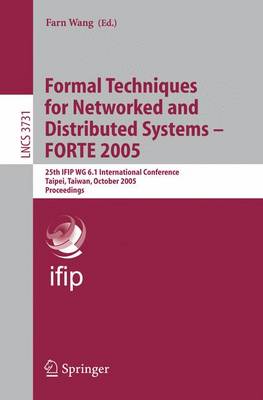Programming and Software Engineering
1 primary work
Book 3731
Formal Techniques for Networked and Distributed Systems Forte 2005
by Farn Wang
Published 1 January 2005
FORTE (Formal Techniques for Networked and Distributed Systems) 2005 was sp- sored by Working Group 6.1, Technical Committee 6 (TC6) of the International Fed- ation for InformationProcessing (IFIP).The conferenceseries started in 1981underthe name PSTV (ProtocolSpeci?cation, Testing, and Veri?cation).In 1988,a second series under the name FORTE was started. Both series merged to FORTE/PSTV in 1996. The conference name was changed to FORTE in 2001. During its 24-year history, many important contributions have been reported in the conference series. The last ?ve me- ings of FORTE were held in Pisa (Italy), Cheju Island (Korea), Houston (USA), Berlin (Germany), and Madrid (Spain). The 25th FORTE was held from Sunday to Wednesday, October 2-5, 2005 on the beautiful campus of the National Taiwan University (NTU), Taipei, Taiwan, ROC. The scope covered formal description techniques (MSC, UML, Use cases, ...), semantic foundations, model-checking, SAT-based techniques, process algebrae, - stractions, protocol testing, protocol veri?cation, network synthesis, security system analysis, network robustness, embedded systems, communication protocols, and s- eral promising new techniques.
In total, we received 88 submissions and accepted 33 regular papers and 6 short papers. All submissions received three reviews. The ?nal program also included 3 keynote speeches, respectively by Prof. Amir Pnueli, Dr. C- stance Heitmeyer, and Prof. Teruo Higashino, and 3 tutorials, respectively by Prof. Rance Cleaveland, Dr. Constance Heitmeyer, and Prof. Teruo Higashino. The proce- ings also include the text of the keynote speeches. In addition, there were social events, including a reception, a banquet, and an excursion.
In total, we received 88 submissions and accepted 33 regular papers and 6 short papers. All submissions received three reviews. The ?nal program also included 3 keynote speeches, respectively by Prof. Amir Pnueli, Dr. C- stance Heitmeyer, and Prof. Teruo Higashino, and 3 tutorials, respectively by Prof. Rance Cleaveland, Dr. Constance Heitmeyer, and Prof. Teruo Higashino. The proce- ings also include the text of the keynote speeches. In addition, there were social events, including a reception, a banquet, and an excursion.
